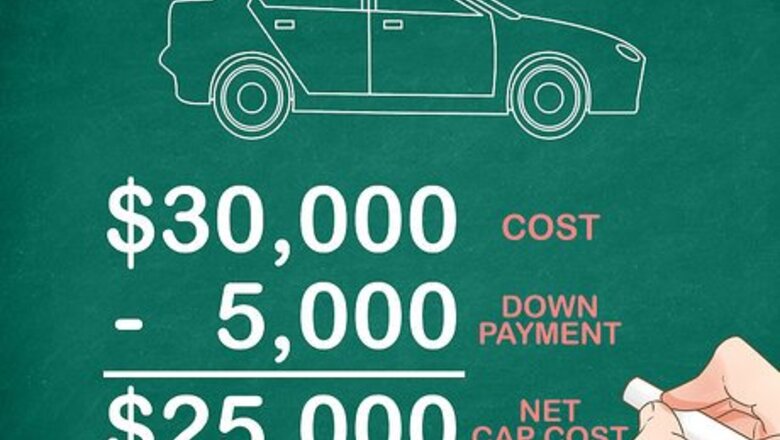
views
Collecting Necessary Data

Determine the net cap cost. The term “net cap cost” is a shortened form of net capitalized cost. This is ultimately the overall price of the vehicle. The net cap cost may be affected by other additions or subtractions, as follows: Any miscellaneous fees or taxes are added to the cost to increase the net cap cost. Any down payment, trade in or rebates are considered “net cap reductions.” These are subtracted and will reduce the net cap cost. Suppose, for example, that a vehicle is listed with a cost of $30,000. There is a rebate or you make a down payment of $5,000. Therefore, the net cap cost for this vehicle is $25,000.

Establish the residual value of the vehicle. This is a bit like predicting the future. The residual value is the vehicle’s value at the end of the lease, when you will return it. This is always a bit uncertain because nobody can predict the exact condition of the vehicle, the mileage or the repairs that it will undergo during the lease. To establish the residual value, dealers use industry guide books, such as the Automotive Leasing Guide (ALG). The graphic shown above illustrates the decline in the vehicle’s value over time. For this example, the residual value at the end of the term is set at $15,000. Some dealers choose not to use the ALG. Instead, they may develop their own guide or functions for setting residual values.

Find out the dealer’s money factor. Leased vehicles do not charge interest in the same way that purchase agreements do. There is, however, a finance charge that is analogous to interest. You are paying the leasing company for the use of their vehicle during the term of your lease. This charge is based on a number called the “money factor.” The money factor is not generally publicized. You will need to ask the dealer to share it with you. The money factor does not look like an interest rate. It will generally be a decimal number like 0.00333. To compare the money factor to an annual interest rate, multiply the money factor by 2400. In this example, a money factor of 0.00333 is roughly like a loan interest rate of 0.00333x2400 = 7.992% interest. This is not an exact equivalence but is a regularly accepted comparison value.
Performing the Calculations

Add the net cap cost and the residual value. The finance charge is based on the sum of the net cap cost and the residual value. At first glance, this appears to be an unfair doubling of the car’s value. However, in combination with the money factor, this works as a way to average the net cap cost and the residual value. You end up paying the finance fee on an average overall value of the car. Consider the example started above. The net cap cost is $25,000, and the residual is $15,000. The total, therefore, is the sum of $25,000+$15,000 = $40,000.

Multiply that sum by the money factor. The money factor is applied to the sum of the net cap cost and the residual value of the car to find the monthly finance charge. Continuing with the example above, use the money factor 0.00333. Multiply this by the sum of the net cap cost and residual as follows: $40,000 x 0.00333 = $133.2.

Apply the monthly finance charge. The result of the final calculation is the monthly finance charge that will be added to your lease payment. In this example, the finance charge is $133.20 each month.

Figure the full monthly payment. The finance charge may be the largest portion of your monthly payment, but you cannot count on it to be the full payment. In addition to the finance charge, many dealers will also charge a depreciation fee. This is the cost that you pay to compensate the dealer for the decreased value of the car over time. Finally, you may be responsible for assorted taxes. Before you sign any lease agreement, you should find out the full monthly charge you are responsible for. Ask the dealer to itemize all the costs for you, and make sure that you understand and can afford them all.
Negotiating with the Dealer

Ask for the data you want. Many people, when leasing a vehicle, seem satisfied to accept the bottom line figure that the dealer assigns. However, to verify that any deal you negotiate is actually honored, you need to know the details of the finance charge calculations. Without asking for the data, you could be the victim of carelessness, simple error, or even fraud. You could negotiate a reduced price for the vehicle, but then the dealer could base the calculations on the original value anyway. The dealer might not apply proper credit for a trade-in vehicle. The dealer could make mathematical errors in calculating the finance charge. The dealer could apply a money factor other than the one used in the original negotiations.

Press the dealer for the “money factor.” The money factor is a decimal number that car dealerships use to calculate the finance charges. This number is not an interest rate but is somewhat analogous to interest rates. Some lease dealers may publicize the money factor, while others may not. You should ask for the money factor that your dealer is using. Also ask how the money factor is used to calculate the finance fee charged on your lease.

Ask the dealer to show you the calculation worksheet. The dealer is not required to share with you the calculations that go into the finance charge and monthly payments on your leased vehicle. Unless you ask specifically, you will probably never see that information. You should ask the dealer, sales clerk or manager to share the calculations with you. Even if you have the individual bits of data, you may not be able to confirm that the figures were calculated accurately or fairly unless you compare your notes to the dealer’s calculations.

Threaten to leave if the dealer is not forthcoming with information. The only leverage you have in the negotiations over a leased vehicle’s finance charges is the ability to walk away. Make it clear to the dealer that you want to verify the calculations and the individual pieces of information that go into figuring your finance charges. If the dealer is unwilling to share this information with you, you should threaten to leave and lease your car from somewhere else.



















Comments
0 comment